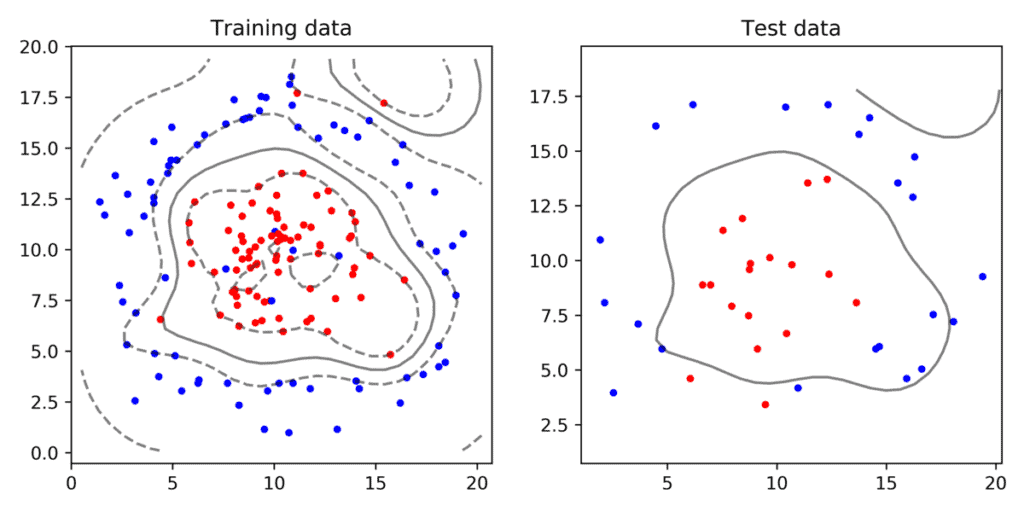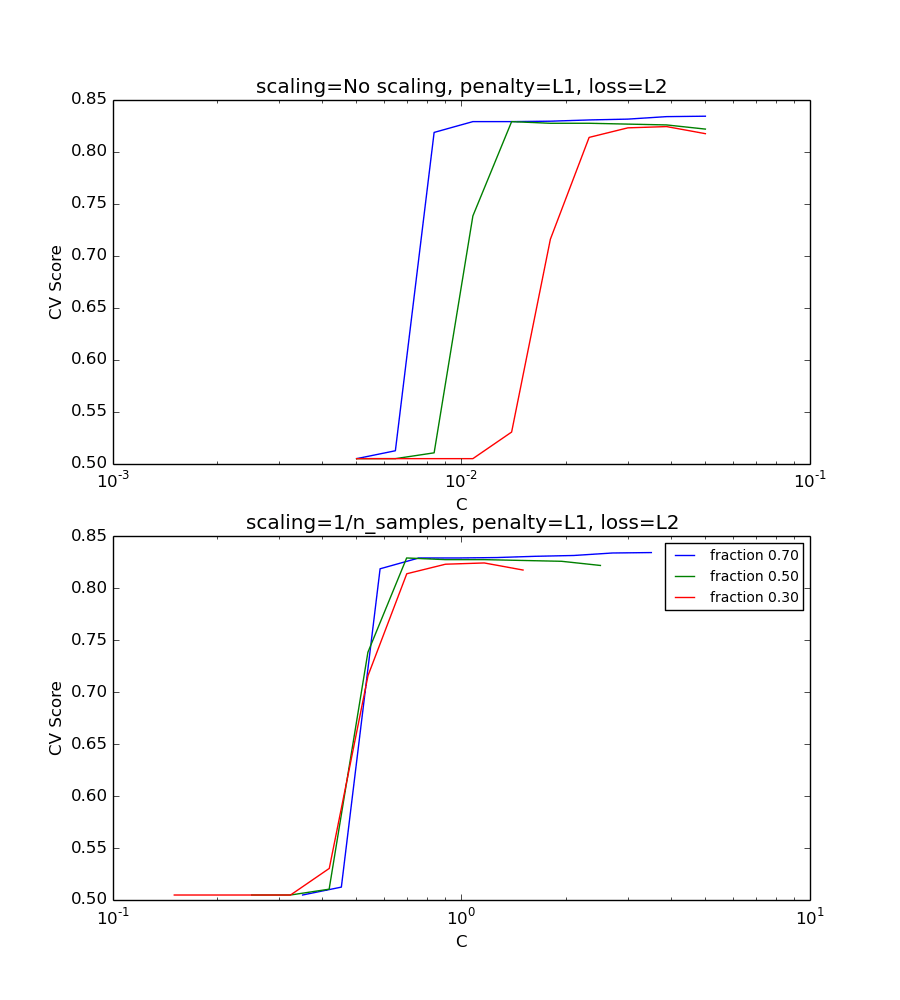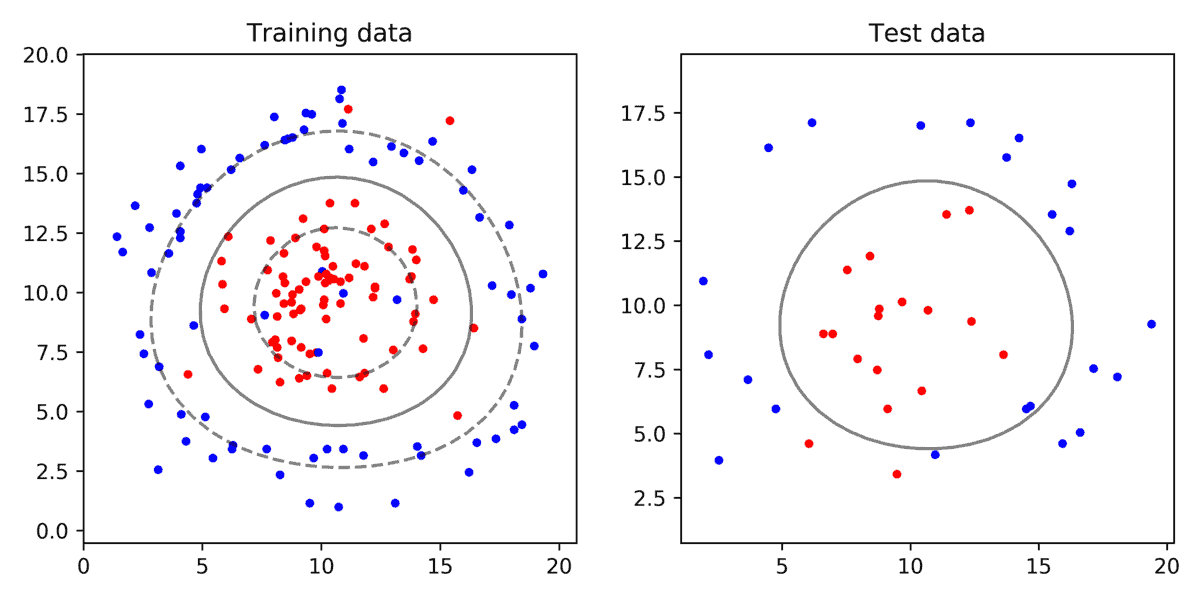Import sklearn svc = sklearn.svm.svc() and maybe, you could do this (depends how the package is setup): If you want, you can just leave parameters blank and use the defaults, like this:
Python Scikit Learn Svm Example, Take a look at the following script: Probability calibration of classifiers ¶.

Finally, let�s use a sigmoid kernel for implementing kernel svm. Clf = svm.svc(kernel=�rbf�, c = 10.0, gamma=0.1) in the above example, we are using the radial basis fucttion expalined in our previous post with parameter gamma set to 0.1. To access objects on it, keep the svm prefix: For now, we�re not going to get into the purpose of these values.

SVM Separating hyperplane for unbalanced classes — scikitlearn 0.11 Rand (40, 1), axis = 0) y = np. Here, we are using linear kernel to fit svm as follows −. Python scikit learn example for beginners. You will also need basic knowledge of the linear svm. Now, of course, we can see with our own eyes how these groups should be divided, though exactly where we might draw the.

Support Vector Regression (SVR) using linear and kernels Getting started with kernel svm Python scikit learn example for beginners. Comparison of calibration of classifiers ¶. Here is a great guide for learning svm classification, especially, for beginners in the field of data science/machine learning. From sklearn.svm import svc svc = svc()

python Plot scikitlearn (sklearn) SVM decision boundary / surface Rand (8)) # ##### # fit regression model svr_rbf = svr (kernel = rbf, c = 100, gamma = 0.1, epsilon = 0.1) svr_lin = svr (kernel =. Clf = svm.svc() though you will get better results with: The linear svm classifier works by drawing a straight line between two classes. Import sklearn svc = sklearn.svm.svc() and maybe, you could.

scikitlearnのSVMでirisデータセットを分類 note.nkmk.me To access objects on it, keep the svm prefix: Clf = svm.svc() though you will get better results with: In this section, we will learn about scikit learn hyperparameter tuning works in python. Support vector machine (svm) is a supervised machine learning algorithm capable of performing classification, regression and even outlier detection. The linear svm classifier works by drawing a.

scikitlearn Supervised Learning Radial Basis Function kernel, RBF From sklearn.svm import svc # support vector classifier model = svc(kernel = �linear�, c = 1e10) model.fit(x, y) the output is as. Ravel # ##### # add noise to targets y [:: Take a look at the following script: You will also need basic knowledge of the linear svm. Import sklearn svc = sklearn.svm.svc() and maybe, you could do this.

SVM using ScikitLearn in Python LearnOpenCV Fit (x, y, sample_weight = none) [source] ¶ fit the svm model according to the given training data. Getting started with kernel svm For now, we�re not going to get into the purpose of these values. Probability calibration of classifiers ¶. Now that we have understood the basics of svm, let’s try to implement it in python.

Support vector machine (Svm classifier) implemenation in python with Here is a great guide for learning svm classification, especially, for beginners in the field of data science/machine learning. Now since y is categorical data, you will need to one hot encode it using sklearn�s labelencoder and scale the input x to do that use. For now, we�re not going to get into the purpose of these values. Libsvm is.

Tuto Python & Scikitlearn SVM classification et régression # create svm classifier based on rbf kernel. In this post, you learn about sklearn libsvm implementation used for training an svm classifier, with code example. For learners to benefit most from this material, they should be comfortable working with the scikit learn library in python. Then, fit your model on train set using fit () and perform prediction on.

Stack Abuse Implementing SVM and Kernel SVM with Python�s ScikitLearn Handan > 미분류 > gaussian kernel svm python. To access objects on it, keep the svm prefix: In the following code, we will import loguniform from sklearn.utils.fixes by which we compare random search and. # create svm classifier based on rbf kernel. Clf = svm.svc() though you will get better results with:

Support vector machine (Svm classifier) implemenation in python with From sklearn.svm import svr from sklearn.datasets import make_regression x,y = make_regression(n_samples, n_features) m = svr() m.fit(x,y) example 13. All the data points that fall on one side of the line will be labeled as one. Def svm_example(n_samples = 10000, n_features = 100): Support vector machine (svm) is a supervised machine learning algorithm capable of performing classification, regression and even outlier.

Support vector machine (Svm classifier) implemenation in python with Just like the intuition that we saw above the implementation is very simple and straightforward with scikit learn’s svm package. In this section, we will learn about scikit learn hyperparameter tuning works in python. Rand (40, 1), axis = 0) y = np. We will consider the weights and size for 20 each. The linear svm classifier works by drawing.

Scaling the regularization parameter for SVCs — scikitlearn 0.15git Rand (40, 1), axis = 0) y = np. We can determine the number of models that need to be built by using this formula: Now that we have understood the basics of svm, let’s try to implement it in python. Handan > 미분류 > gaussian kernel svm python. Libsvm is a library for support vector machines (svm) which provides.

SVM using ScikitLearn in Python LearnOpenCV It is designed to work with numpy and pandas library. The linear svm classifier works by drawing a straight line between two classes. For learners to benefit most from this material, they should be comfortable working with the scikit learn library in python. Scikit learn is written in python (most. Here, we are using linear kernel to fit svm as.

【Scikitlearn】SVMモデルでアヤメの品種分類(Irisデータセット) 西住工房 Support vector machine (svm) is a supervised machine learning algorithm capable of performing classification, regression and even outlier detection. Clf = svm.svc(kernel=�rbf�, c = 10.0, gamma=0.1) in the above example, we are using the radial basis fucttion expalined in our previous post with parameter gamma set to 0.1. In the following code, we will import loguniform from sklearn.utils.fixes by which.

Python Programming Tutorials Def svm_example(n_samples = 10000, n_features = 100): Getting started with kernel svm Comparison of calibration of classifiers ¶. Handan > 미분류 > gaussian kernel svm python. Get code examples likescikit learn svm.

Machine Learning in Python classification using Support Vector Scikit learn is written in python (most. If you want, you can just leave parameters blank and use the defaults, like this: Import sklearn svc = sklearn.svm.svc() and maybe, you could do this (depends how the package is setup): For now, we�re not going to get into the purpose of these values. Now since y is categorical data, you will.

Support vector machine (Svm classifier) implemenation in python with For example, the second line: Get code examples likescikit learn svm. From sklearn.svm import svr from sklearn.datasets import make_regression x,y = make_regression(n_samples, n_features) m = svr() m.fit(x,y) example 13. We can determine the number of models that need to be built by using this formula: Support vector machine (svm) is a supervised machine learning algorithm capable of performing classification, regression.

Plot different SVM classifiers in the iris dataset — scikitlearn 0.15 Fit (x, y, sample_weight = none) [source] ¶ fit the svm model according to the given training data. From sklearn.svm import svr from sklearn.datasets import make_regression x,y = make_regression(n_samples, n_features) m = svr() m.fit(x,y) example 13. In this post, you learn about sklearn libsvm implementation used for training an svm classifier, with code example. Rand (40, 1), axis = 0).

scikitlearnで機械学習を試す SVM Qiita Indeep, the kernel svm offers more flexibility when dealing with a linearly inseparable classification task. If you want, you can just leave parameters blank and use the defaults, like this: Clf = svm.svc(gamma=0.001, c=100) this chooses the svc, and we set gamma and c. Probability calibration of classifiers ¶. Now that we have understood the basics of svm, let’s try.

Support vector machine (Svm classifier) implemenation in python with Rand (40, 1), axis = 0) y = np. Hyperparameter tuning is defined as a parameter that passed as an argument to the constructor of the estimator classes. We can determine the number of models that need to be built by using this formula: From sklearn.svm import svc # support vector classifier model = svc(kernel = �linear�, c = 1e10).

SVM using ScikitLearn in Python LearnOpenCV You are importing the svm name from within the sklearn package, into your module as �svm�. Take a look at the following script: From sklearn.svm import svc svclassifier = svc (kernel= �sigmoid� ) svclassifier.fit (x_train, y_train) to use the sigmoid kernel, you have to specify �sigmoid� as value for the kernel parameter of the svc class. The factor and all.

Python Programming Tutorials It is designed to work with numpy and pandas library. Here is a great guide for learning svm classification, especially, for beginners in the field of data science/machine learning. In the following code, we will import loguniform from sklearn.utils.fixes by which we compare random search and. X = iris [ [�sepal length:�,�sepal width:�,�petal length�,�petal width�]].values y = iris [ [�target�]].values..

SVM using ScikitLearn in Python LearnOpenCV Svc = svm.svc() another example, you could also do it like this: Ravel # ##### # add noise to targets y [:: From sklearn.svm import svc svc = svc() Now, of course, we can see with our own eyes how these groups should be divided, though exactly where we might draw the dividing line might be debated: You are importing.

SVM with custom kernel — scikitlearn 0.17 文档 Now you will need your x and y as numpy arrays, to do that use. Handan > 미분류 > gaussian kernel svm python. It is designed to work with numpy and pandas library. Finally, let�s use a sigmoid kernel for implementing kernel svm. Then, fit your model on train set using fit () and perform prediction on the test set.

【Scikitlearn】SVMモデルでアヤメの品種分類(Irisデータセット) 西住工房 Fit (x, y, sample_weight = none) [source] ¶ fit the svm model according to the given training data. Python scikit learn example for beginners. Svm will choose the line that maximizes the margin. The linear svm classifier works by drawing a straight line between two classes. It is designed to work with numpy and pandas library.
Ravel # ##### # add noise to targets y [:: 【Scikitlearn】SVMモデルでアヤメの品種分類(Irisデータセット) 西住工房.
From sklearn.svm import svc svc = svc() Clf = svm.svc(gamma=0.001, c=100) this chooses the svc, and we set gamma and c. Additionally, we will cover these topics. Import sklearn svc = sklearn.svm.svc() and maybe, you could do this (depends how the package is setup): Rand (40, 1), axis = 0) y = np. Indeep, the kernel svm offers more flexibility when dealing with a linearly inseparable classification task.
Python scikit learn example for beginners. For now, we�re not going to get into the purpose of these values. Clf = svm.svc(kernel=�rbf�, c = 10.0, gamma=0.1) in the above example, we are using the radial basis fucttion expalined in our previous post with parameter gamma set to 0.1. 【Scikitlearn】SVMモデルでアヤメの品種分類(Irisデータセット) 西住工房, Comparison of calibration of classifiers ¶.







